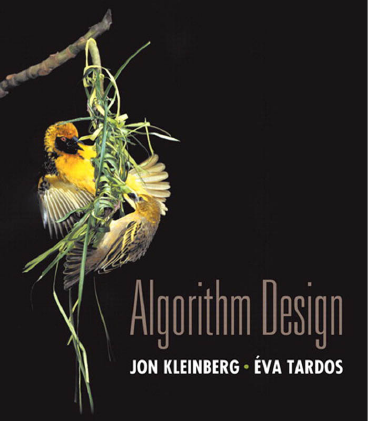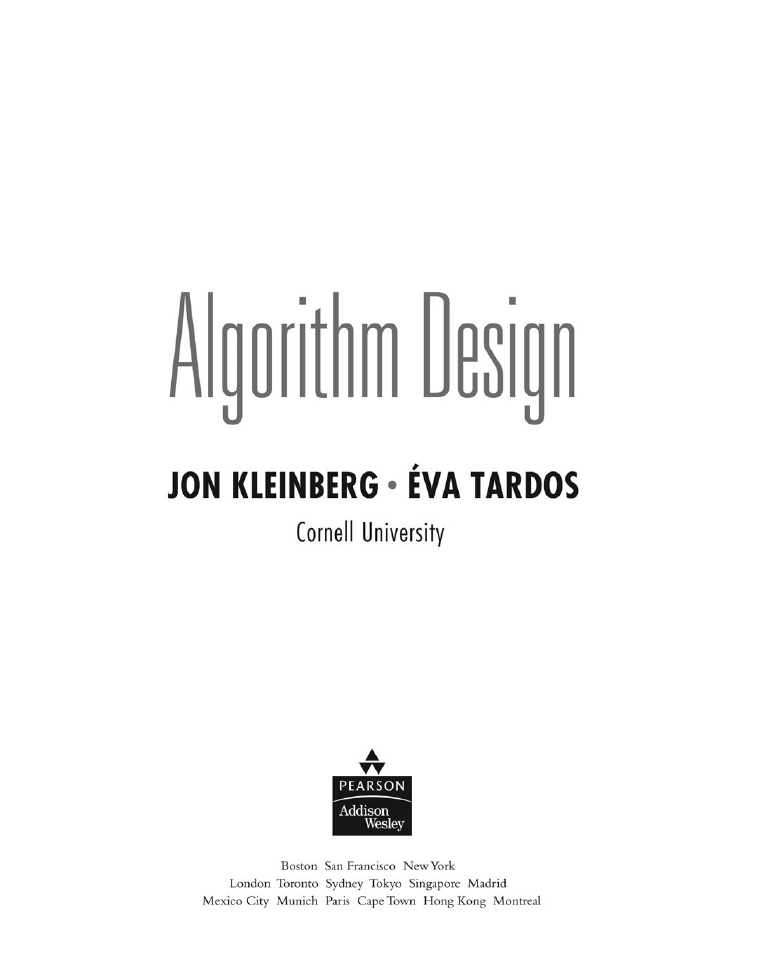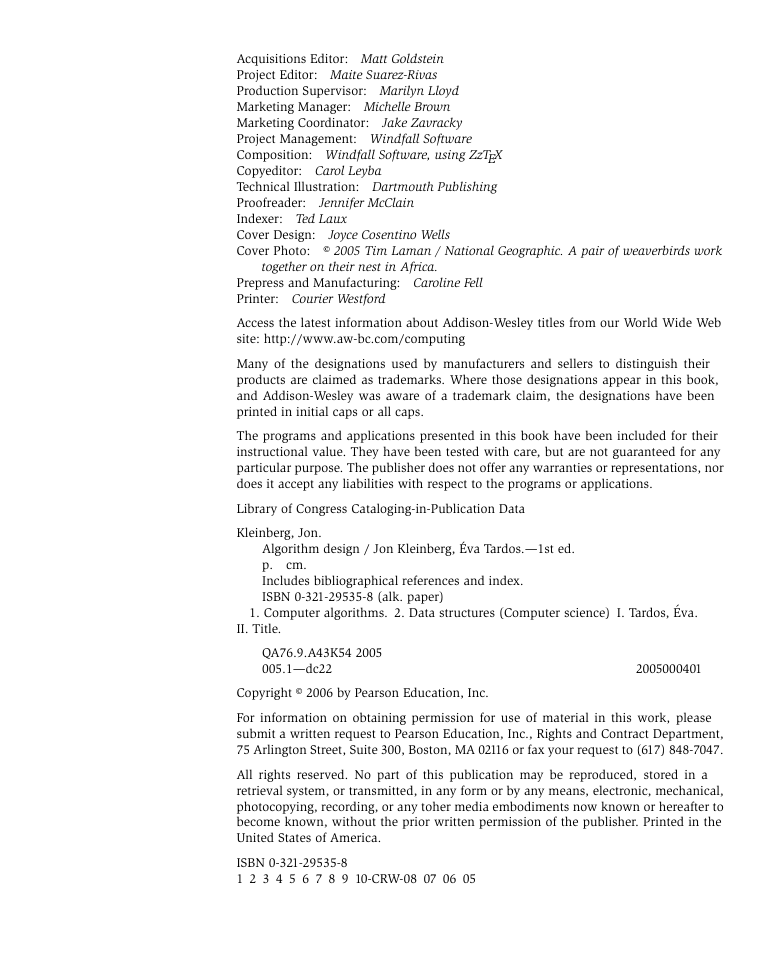Cover
Title Page
Copyright Page
Contents
About the Authors
Preface
Acknowledgments
1 Introduction: Some Representative Problems
1.1 A First Problem: Stable Matching
1.2 Five Representative Problems
Solved Exercises
Exercises
Notes and Further Reading
2 Basics of Algorithm Analysis
2.1 Computational Tractability
2.2 Asymptotic Order of Growth
2.3 Implementing the Stable Matching Algorithm Using Lists and Arrays
2.4 A Survey of Common Running Times
2.5 A More Complex Data Structure: Priority Queues
Solved Exercises
Exercises
Notes and Further Reading
3 Graphs
3.1 Basic Definitions and Applications
3.2 Graph Connectivity and Graph Traversal
3.3 Implementing Graph Traversal Using Queues and Stacks
3.4 Testing Bipartiteness: An Application of Breadth-First Search
3.5 Connectivity in Directed Graphs
3.6 Directed Acyclic Graphs and Topological Ordering
Solved Exercises
Exercises
Notes and Further Reading
4 Greedy Algorithms
4.1 Interval Scheduling: The Greedy Algorithm Stays Ahead
4.2 Scheduling to Minimize Lateness: An Exchange Argument
4.3 Optimal Caching: A More Complex Exchange Argument
4.4 Shortest Paths in a Graph
4.5 The Minimum Spanning Tree Problem
4.6 Implementing Kruskal?s Algorithm: The Union-Find Data Structure
4.7 Clustering
4.8 Huffman Codes and Data Compression
*4.9 Minimum-Cost Arborescences: A Multi-Phase Greedy Algorithm
Solved Exercises
Exercises
Notes and Further Reading
5 Divide and Conquer
5.1 A First Recurrence: The Mergesort Algorithm
5.2 Further Recurrence Relations
5.3 Counting Inversions
5.4 Finding the Closest Pair of Points
5.5 Integer Multiplication
5.6 Convolutions and the Fast Fourier Transform
Solved Exercises
Exercises
Notes and Further Reading
6 Dynamic Programming
6.1 Weighted Interval Scheduling: A Recursive Procedure
6.2 Principles of Dynamic Programming: Memoization or Iteration over Subproblems
6.3 Segmented Least Squares: Multi-way Choices
6.4 Subset Sums and Knapsacks: Adding a Variable
6.5 RNA Secondary Structure: Dynamic Programming over Intervals
6.6 Sequence Alignment
6.7 Sequence Alignment in Linear Space via Divide and Conquer
6.8 Shortest Paths in a Graph
6.9 Shortest Paths and Distance Vector Protocols
*6.10 Negative Cycles in a Graph
Solved Exercises
Exercises
Notes and Further Reading
7 Network Flow
7.1 The Maximum-Flow Problem and the Ford-Fulkerson Algorithm
7.2 Maximum Flows and Minimum Cuts in a Network
7.3 Choosing Good Augmenting Paths
*7.4 The Preflow-Push Maximum-Flow Algorithm
7.5 A First Application: The Bipartite Matching Problem
7.6 Disjoint Paths in Directed and Undirected Graphs
7.7 Extensions to the Maximum-Flow Problem
7.8 Survey Design
7.9 Airline Scheduling
7.10 Image Segmentation
7.11 Project Selection
7.12 Baseball Elimination
*7.13 A Further Direction: Adding Costs to the Matching Problem
Solved Exercises
Exercises
Notes and Further Reading
8 NP and Computational Intractability
8.1 Polynomial-Time Reductions
8.2 Reductions via ?Gadgets?: The Satisfiability Problem
8.3 Efficient Certification and the Definition of NP
8.4 NP-Complete Problems
8.5 Sequencing Problems
8.6 Partitioning Problems
8.7 Graph Coloring
8.8 Numerical Problems
8.9 Co-NP and the Asymmetry of NP
8.10 A Partial Taxonomy of Hard Problems
Solved Exercises
Exercises
Notes and Further Reading
9 PSPACE: A Class of Problems beyond NP
9.1 PSPACE
9.2 Some Hard Problems in PSPACE
9.3 Solving Quanti.ed Problems and Games in Polynomial Space
9.4 Solving the Planning Problem in Polynomial Space
9.5 Proving Problems PSPACE-Complete
Solved Exercises
Exercises
Notes and Further Reading
10 Extending the Limits of Tractability
10.1 Finding Small Vertex Covers
10.2 Solving NP-Hard Problems on Trees
10.3 Coloring a Set of Circular Arcs
*10.4 Tree Decompositions of Graphs
*10.5 Constructing a Tree Decomposition
Solved Exercises
Exercises
Notes and Further Reading
11 Approximation Algorithms
11.1 Greedy Algorithms and Bounds on the Optimum: A Load Balancing Problem
11.2 The Center Selection Problem
11.3 Set Cover: A General Greedy Heuristic
11.4 The Pricing Method: Vertex Cover
11.5 Maximization via the Pricing Method: The Disjoint Paths Problem
11.6 Linear Programming and Rounding: An Application to Vertex Cover
*11.7 Load Balancing Revisited: A More Advanced LP Application
11.8 Arbitrarily Good Approximations: The Knapsack Problem
Solved Exercises
Exercises
Notes and Further Reading
12 Local Search
12.1 The Landscape of an Optimization Problem
12.2 The Metropolis Algorithm and Simulated Annealing
12.3 An Application of Local Search to Hopfield Neural Networks
12.4 Maximum-Cut Approximation via Local Search
12.5 Choosing a Neighbor Relation
*12.6 Classification via Local Search
12.7 Best-Response Dynamics and Nash Equilibria
Solved Exercises
Exercises
Notes and Further Reading
13 Randomized Algorithms
13.1 A First Application: Contention Resolution
13.2 Finding the Global Minimum Cut
13.3 Random Variables and Their Expectations
13.4 A Randomized Approximation Algorithm for MAX 3-SAT
13.5 Randomized Divide and Conquer: Median-Finding and Quicksort
13.6 Hashing: A Randomized Implementation of Dictionaries
13.7 Finding the Closest Pair of Points: A Randomized Approach
13.8 Randomized Caching
13.9 Chernoff Bounds
13.10 Load Balancing
13.11 Packet Routing
13.12 Background: Some Basic Probability Definitions
Solved Exercises
Exercises
Notes and Further Reading
Epilogue: Algorithms That Run Forever
References
Index
A
B
C
D
E
F
G
H
I
J
K
L
M
N
O
P
Q
R
S
T
U
V
W
Y
Z
















 2023年江西萍乡中考道德与法治真题及答案.doc
2023年江西萍乡中考道德与法治真题及答案.doc 2012年重庆南川中考生物真题及答案.doc
2012年重庆南川中考生物真题及答案.doc 2013年江西师范大学地理学综合及文艺理论基础考研真题.doc
2013年江西师范大学地理学综合及文艺理论基础考研真题.doc 2020年四川甘孜小升初语文真题及答案I卷.doc
2020年四川甘孜小升初语文真题及答案I卷.doc 2020年注册岩土工程师专业基础考试真题及答案.doc
2020年注册岩土工程师专业基础考试真题及答案.doc 2023-2024学年福建省厦门市九年级上学期数学月考试题及答案.doc
2023-2024学年福建省厦门市九年级上学期数学月考试题及答案.doc 2021-2022学年辽宁省沈阳市大东区九年级上学期语文期末试题及答案.doc
2021-2022学年辽宁省沈阳市大东区九年级上学期语文期末试题及答案.doc 2022-2023学年北京东城区初三第一学期物理期末试卷及答案.doc
2022-2023学年北京东城区初三第一学期物理期末试卷及答案.doc 2018上半年江西教师资格初中地理学科知识与教学能力真题及答案.doc
2018上半年江西教师资格初中地理学科知识与教学能力真题及答案.doc 2012年河北国家公务员申论考试真题及答案-省级.doc
2012年河北国家公务员申论考试真题及答案-省级.doc 2020-2021学年江苏省扬州市江都区邵樊片九年级上学期数学第一次质量检测试题及答案.doc
2020-2021学年江苏省扬州市江都区邵樊片九年级上学期数学第一次质量检测试题及答案.doc 2022下半年黑龙江教师资格证中学综合素质真题及答案.doc
2022下半年黑龙江教师资格证中学综合素质真题及答案.doc